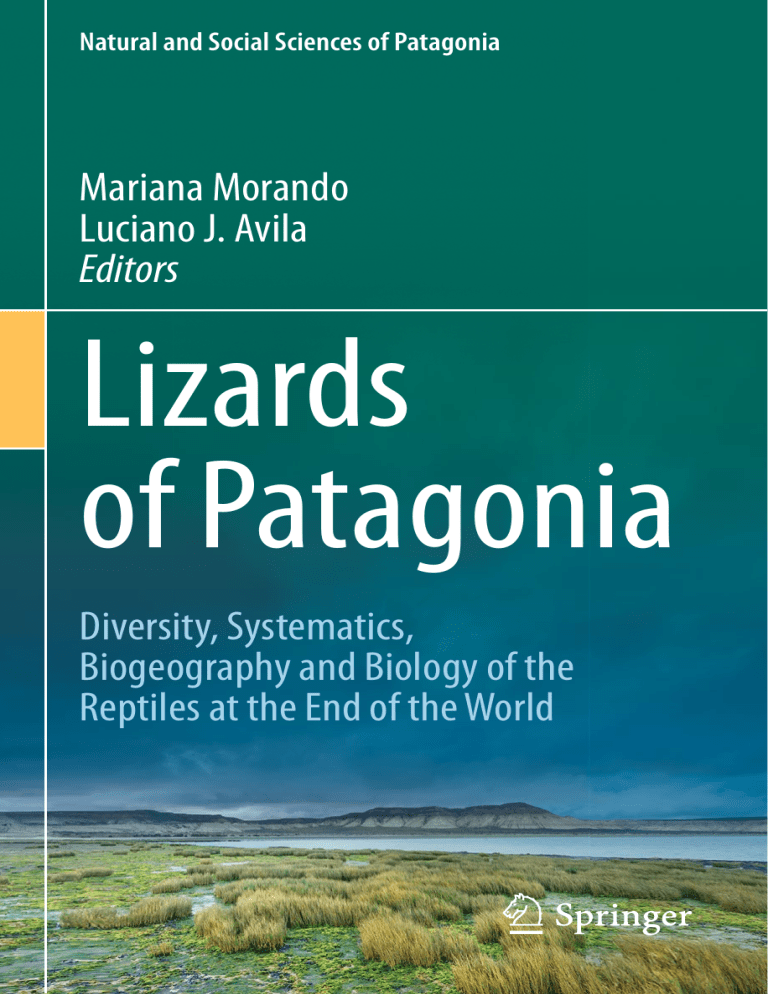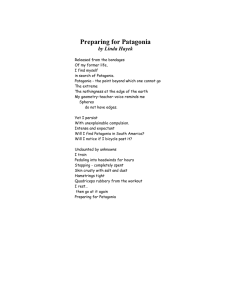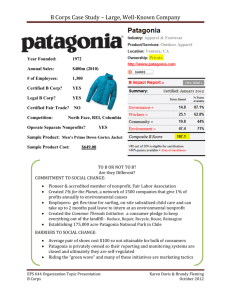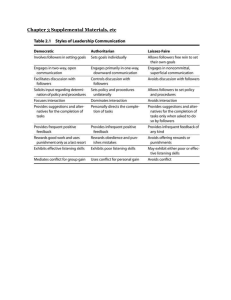
Natural and Social Sciences of Patagonia Mariana Morando Luciano J. Avila Editors Lizards of Patagonia Diversity, Systematics, Biogeography and Biology of the Reptiles at the End of the World Editors Mariana Morando Instituto Patagónico para el Estudio de los Ecosistemas Continentales Consejo Nacional de Investigaciones Científicas y Técnicas Puerto Madryn, Chubut, Argentina Luciano J. Avila Instituto Patagónico para el Estudio de los Ecosistemas Continentales Consejo Nacional de Investigaciones Científicas y Técnicas Puerto Madryn, Chubut, Argentina ISSN 2662-3463 ISSN 2662-3471 (electronic) Natural and Social Sciences of Patagonia ISBN 978-3-030-42751-1 ISBN 978-3-030-42752-8 (eBook) https://doi.org/10.1007/978-3-030-42752-8 © Springer Nature Switzerland AG 2020 This work is subject to copyright. All rights are reserved by the Publisher, whether the whole or part of the material is concerned, specifically the rights of translation, reprinting, reuse of illustrations, recitation, broadcasting, reproduction on microfilms or in any other physical way, and transmission or information storage and retrieval, electronic adaptation, computer software, or by similar or dissimilar methodology now known or hereafter developed. The use of general descriptive names, registered names, trademarks, service marks, etc. in this publication does not imply, even in the absence of a specific statement, that such names are exempt from the relevant protective laws and regulations and therefore free for general use. The publisher, the authors, and the editors are safe to assume that the advice and information in this book are believed to be true and accurate at the date of publication. Neither the publisher nor the authors or the editors give a warranty, expressed or implied, with respect to the material contained herein or for any errors or omissions that may have been made. The publisher remains neutral with regard to jurisdictional claims in published maps and institutional affiliations. This Springer imprint is published by the registered company Springer Nature Switzerland AG The registered company address is: Gewerbestrasse 11, 6330 Cham, Switzerland Contents Part I Historical and General Background 1History of Discovery of the Patagonian Lizards ���������������������������������� 3 Jorge D. Williams, Camila Kass, and Luciano J. Avila 2The Relationship Between People and Lizards in Patagonia�������������� 25 Juana Aigo, Ana Ladio, Jorgelina M. Boretto, Facundo Cabezas-Cartes, and Nora R. Ibargüengoytía Part II Land, Climate and Vegetation Background 3Geographical Singularities of the Patagonian Climate������������������������ 43 Fernando Raúl Coronato 4Landscapes and Geology of Patagonia: An Introduction to the Land of Reptiles���������������������������������������������������������������������������� 59 Pablo José Bouza and Andrés Bilmes 5Vegetation of Patagonia �������������������������������������������������������������������������� 85 Alejandro Jorge Bisigato and Mónica Beatriz Bertiller Part III Diversity and Current Knowledge of Patagonian Lizards 6The Patagonian Fossil Lizards���������������������������������������������������������������� 105 Adriana María Albino 7Naming the Diversity: Taxonomy of Current Species of Patagonian Lizards������������������������������������������������������������������������������������������������������ 123 Luciano J. Avila, Andrea González Marín, Jaime Troncoso-­Palacios, Kevin Imanol Sánchez, Cristian Hernán Fulvio Pérez, and Mariana Morando xv xvi Contents 8Biogeography, Ecology, and Spatial Patterns of Patagonian Lizards������������������������������������������������������������������������������ 189 Ignacio Minoli, Cristian Hernán Fulvio Pérez, Mariana Morando, and Luciano J. Avila 9Diversification and Evolutionary Histories of Patagonian Steppe Lizards������������������������������������������������������������������������������������������ 217 Mariana Morando, Cintia Débora Medina, Ignacio Minoli, Cristian Hernán Fulvio Pérez, Jack W. Sites Jr, and Luciano J. Avila 10Phylogeography of Chilean Lizards: Histories of Genetic Diversification on the Western Slope of Southern Andes �������������������� 255 Pedro F. Victoriano 11General Ecology of Patagonian Lizards������������������������������������������������ 293 Juan Carlos Acosta, Rodrigo Gómez Alés, Graciela Blanco, Paula C. Escudero, and Luciano J. Avila 12Reproductive Biology of Lizards from Patagonia, Argentina: Physiological and Behavioral Adaptations to Cold and Harsh Environments���������������������������������������������������������� 335 Jorgelina M. Boretto, Jimena B. Fernández, Facundo Cabezas-­Cartes, Marlin S. Medina, and Nora R. Ibargüengoytía 13Effects of Acute and Chronic Environmental Disturbances on Lizards of Patagonia�������������������������������������������������������������������������� 373 Nora R. Ibargüengoytía, Erika Kubisch, Facundo Cabezas-Cartes, Jimena B. Fernández, Fernando Duran, Carla Piantoni, Marlin S. Medina, and Barry Sinervo 14Conservation Concerns About the Southernmost Lizards of the World���������������������������������������������������������������������������������������������� 407 Federico Pablo Kacoliris, Ignacio Minoli, Camila Kass, and Diego Omar Di Pietro Index������������������������������������������������������������������������������������������������������������������ 423 Chapter 5 Vegetation of Patagonia Alejandro Jorge Bisigato and Mónica Beatriz Bertiller Abstract In this chapter, we describe the major phytogeographic provinces of Patagonia. Emphasis is placed on physiognomic vegetation formations, internal heterogeneity, and degree of anthropic disturbance. Main vegetation formations within provinces include temperate forests, steppes, moorlands, and shrublands. Internal plant heterogeneity is high in all provinces and is associated with climate, soils, altitude, and natural (e.g., volcanism) or anthropogenic disturbances. The most important anthropogenic disturbance varies among provinces in relation to vegetation formations. Domestic grazing is a widespread disturbance agent in steppes and shrublands, while oil and natural gas extraction may also cause disturbances affecting local plant communities in some areas. In contrast, clearing for agriculture and afforestation are common in temperate forests. Invasion of exotic plants and animals are also a threat for the conservation of pristine vegetation. Disturbances, together with the ongoing climate change, can strongly influence vegetation structure and functioning that in turn could affect populations of wild animals, particularly lizards. Keywords Patagonia · Vegetation heterogeneity · Climate · Disturbance · Grazing · Deforestation/afforestation 5.1 Introduction Patagonian vegetation encompasses a wide range of physiognomic vegetation formations from forests to arid steppes and moorlands. In general, most studies of Patagonian vegetation were restricted either to Chilean (e.g., Quintanilla Pérez 1985, 1989; Gajardo 1994; Luebert and Pliscoff 2006) or Argentinean Patagonia (e.g., Soriano 1956, 1983; León et al. 1998). Syntheses attempting to gather descriptions A. J. Bisigato (*) · M. B. Bertiller Instituto Patagónico para el Estudio de los Ecosistemas Continentales – Consejo Nacional de Investigaciones Científicas y Técnicas (IPEEC-CONICET), Puerto Madryn, Chubut, Argentina e-mail: bisigato@cenpat-conicet.gob.ar; monika@cenpat-conicet.gob.ar © Springer Nature Switzerland AG 2020 M. Morando, L. J. Avila (eds.), Lizards of Patagonia, Natural and Social Sciences of Patagonia, https://doi.org/10.1007/978-3-030-42752-8_5 85 86 A. J. Bisigato and M. B. Bertiller of vegetation made in both countries are infrequent (e.g., Heusser 2003; Gut 2008) mainly due to different approaches, perspectives, and methods used to delimit different “vegetation units.” As in the rest of this book, we refer to Patagonia as the area delimited by the Tinguiririca, Atuel, Salado, Chadileuvu, and Colorado rivers. Following Morrone (2001a) and Morrone (2004, 2006), most of this area belongs to the Andean Region. Only the northern extreme in the Argentinean Patagonia occupies part of the South American transition zone (Urtubey et al. 2010), to which Morrone reassigned some provinces previously ascribed to the Neotropical region (Morrone 2004, 2006). Overall, we followed the classification of Morrone (2001a), who in his book Biogeografía de América Latina y el Caribe analyzed Patagonian vegetation without restrictions due to country limits, along with subsequent descriptions modifying some boundaries among provinces in Morrone (2014, 2015). The names of some provinces (but not their limits) were modified according to more recent works (e.g., Morrone and Ezcurra 2016). Patagonian vegetation mirrors the marked climatic differences across the region imposed by the elevation of the Andes Mountains, disrupting the large-scale circulation of air masses. In fact, the Andes have a critical influence in determining the climate of Patagonia by imposing a barrier for humid air masses from the Pacific Ocean. As a consequence, most of water is discharged at the west slope of the Andes (on the Chilean side) and dry and hot air descends at the east side of the Andes over the Argentinean Patagonia (Paruelo et al. 1998; Labraga and Villalba 2009). Accordingly, forests and moorlands occupy most of the Chilean Patagonia, whereas the largest area of the Argentinean Patagonia is part of the South American Arid Diagonal covered by steppes, semideserts, and shrublands. In this context, Patagonian forests have evolved since the Pliocene in isolation from other South American forests being more closely related to Australian and New Zealand forests (Villagrán and Hinojosa 1997; Villagrán and Armesto 2005). Latitude, as a surrogate of temperature, also affects plant distribution along this extended region. For example, the tree line is at 2150 m at 33° S but descends to 350 m at 55° S (Heusser 2003). Vegetation heterogeneity due to differences in soil attributes is also present at finer scales than those imposed by climate (e.g., Rueter and Bertolami 2010; Palacio et al. 2014; Casalini and Bisigato 2017). Across Patagonia, azonal plant communities occupy small areas with particular soil attributes conditioning higher or lower water availability than at zonal communities. For example, azonal wet meadows, locally known as mallines, with more mesic vegetation than the surrounding steppes may be found in arid Patagonia (Soriano 1983; Buono et al. 2010; Gaitán et al. 2011). Similarly, a strong local soil-vegetation relationship may be found at the forest humid sites, where zonal forest vegetation may include patches of azonal grasslands and Sphagnum bogs (Holdgate 1961). Despite this, only regional zonal vegetation formations will be considered in this chapter. In the next sections we present a general description of vegetation of the Patagonian phytogeographic provinces including dominant physiognomies, the most common species, and a mention of their internal heterogeneity. A detailed description (and mapping) of vegetation units inside provinces (e.g., districts) is out of the scope of this chapter, since previous studies provided excellent detailed 5 Vegetation of Patagonia 87 descriptions (e.g., Soriano 1956; Gajardo 1994; León et al. 1998; Luebert and Pliscoff 2006). Furthermore, there are many studies describing and mapping plant assemblages in different areas of Patagonia (e.g., Bertiller et al. 1981, 2017; Quintanilla Pérez 1985, 1989; Beeskow et al. 1987; Rueter and Bertolami 2010; Bisigato et al. 2016). Due to its extension and great variability, we exceptionally briefly describe subprovinces within the Patagonian Province. Plant nomenclature follows Flora Argentina (http://www.floraargentina.edu.ar/) for Argentinean species and Catálogo de las Plantas Vasculares de Chile (Rodríguez et al. 2018) for the Chilean flora. Authorities for species names are detailed in Appendix. 5.2 Phytogeographic Provinces 5.2.1 South American Transition Zone 5.2.1.1 Monte Province The Monte Province occupies 526,000 km2 in west Argentina (Bisigato et al. 2009) but only 280,300 km2 cover the northeastern Argentinean Patagonia. This portion of the territory is located east of the isotherm of 13° C, reaching 44° S (Morrone 2001a; Rundel et al. 2007; Abraham et al. 2009; Oyarzábal et al. 2018) (Fig. 5.1). Precipitation ranges from 116 to 200 mm (Labraga and Villalba 2009, Coronato [Chap. 2]). Vegetation is characterized by shrubby plant communities dominated by species of the genus Larrea (L. divaricata, L. nitida, L. ameghinoi, and L. cuneifolia; Fig. 5.2). Other common shrubs are Prosopis flexuosa, P. alpataco, Prosopidastrum striatum, Monttea aphylla, Bougainvillea spinosa, Condalia microphylla, and several species of the genus Lycium, Chuquiraga, and Gutierrezia (León et al. 1998; Oyarzábal et al. 2018). Grasses of the genus Poa, Pappostipa, and Nassella are common, especially at the southern extreme of this province. In general, plant cover is low but it increases near the Atlantic Ocean due to greater precipitation (León et al. 1998). In this area, small groups of Geoffroea decorticans individuals are common. Overgrazing is a widespread disturbance (Bisigato and Bertiller 1997; Tadey 2006; Villagra et al. 2009), but impacts by vegetation removal for hydrocarbon extraction are particularly important in the north (Neuquén Province) (Radovani et al. 2014). Wildfires are also common (Hardtke et al. 2011) deeply affecting vegetation structure and function (Rostagno et al. 2006; Villagra et al. 2009). 5.2.1.2 Cuyan High Andean Province The Cuyan High Andean Province, originally named Prepuna Province (Morrone 2001a), extends mainly in western Argentina, reaching neighboring areas in central Chile, north of 38° S (Morrone and Ezcurra 2016) (Fig. 5.1). It includes several of the highest mountains of South America. Climate is windy and very cold (Arroyo 88 A. J. Bisigato and M. B. Bertiller Fig. 5.1 Vegetation map of Patagonia. Redrawn from Romano (2017) showing the phytogeographical provinces and administrative divisions (regions in Chile and provinces in Argentina). We modified the northeastern limit of the Monte Province following Oyarzábal et al. (2018) and the western limit of the Cuyan High Andean Province following Luebert and Pliscoff (2006) and Cavieres 2013). Only the southern extreme of this province is included in Patagonia, covering 19,900 km2. Dominant species are a mixture of perennial herbs, low rounded shrubs, and cushion plants (Fig. 5.3): Senecio algens, Oxalis compacta, Oxalis adenophylla, Pozoa coriacea, Laretia acaulis, Berberis empetrifolia, Chuquiraga oppositifolia, and Discaria articulata (Luebert and Pliscoff 2006; Arroyo and Cavieres 2013; Oyarzábal et al. 2018). 5 Vegetation of Patagonia 89 Fig. 5.2 Monte Province. Dominant Larrea divaricata shrublands in the southern portion in Chubut, Argentina (Photo: A. Bisigato) Fig. 5.3 Cuyan High Andean Province near Laguna del Maule, Chile (Photo: L. Avila) 90 A. J. Bisigato and M. B. Bertiller 5.2.2 Andean Region 5.2.2.1 Santiago Province The Santiago Province is located north of 38° S and is the most arid province among the Chilean Patagonian provinces (Fig. 5.1). This is partially due to low precipitation induced by the coastal cordillera, but mostly to high temperatures and a summer dry season (Heusser 2003; Armesto et al. 2007). Only the southern tip of this province (62,900 km2) is included in the Patagonian region, as defined in this book. Scrublands are the dominant physiognomy, although small Mediterranean woodlands can also be found (Morrone 2001a). Dominant species are Vachellia caven, Peumus boldus, Fabiana imbricata, Lithraea caustica, and Quillaja saponaria (Gajardo 1994; Heusser 2003; Luebert and Pliscoff 2006). Major threats to conservation are deforestation, wildfires, overgrazing, firewood collection, afforestation with exotic tree species, and invasion of exotic species (Morrone 2001a; Lara et al. 2012). 5.2.2.2 Maule Province The Maule Province occupies 59,000 km2 in Chile and Argentina, south of the province of Santiago (38° to 40° S, Fig. 5.1) (Morrone 2000; Gut 2008). Climate is humid and temperate without a dry season. Pristine vegetation is mostly represented by a deciduous forest, but it was almost completely converted to agricultural land (Gajardo 1994; Heusser 2003; Lara et al. 2012). In the few relicts of native vegetation, the dominant species is Nothofagus obliqua, but other cogeneric species are also common (N. dombeyi, and N. alpina). Different communities, co-dominated by Austrocedrus chilensis, Laurelia sempervirens, Podocarpus saligna, Dasyphyllum diacanthoides, Cryptocarya alba, and/or Persea lingue are distinguishable (Gajardo 1994; Heusser 2003; Luebert and Pliscoff 2006). On the coastal cordillera, pristine vegetation is co-dominated by N. obliqua and Gomortega keule, but it was almost completely replaced by Pinus radiata plantations. Primeval vegetation on the central valley was dominated by N. obliqua, accompanied by N. dombeyi at the north and by L. sempervirens at the south. Small forests of Araucaria araucana and Nothofagus pumilio can be found at altitudes higher than 1000 m (Fig. 5.4). Deforestation and afforestation with exotic tree species are the most important risks for vegetation conservation (Morrone 2001a; Lara et al. 2012; Franzese et al. 2017). 5.2.2.3 Valdivian Forest Province The Valdivian Forest Province occupies 166,000 km2 in Chile and Argentina, south of the Maule Province reaching 47° S (Morrone 2000, Fig. 5.1). Climate is cold, wet, and cloudy. In contrast to Maule Province, evergreen forest is the prevailing 5 Vegetation of Patagonia 91 Fig. 5.4 Maule Province. Araucaria araucana forest in Neuquén, Argentina (Photo: M. Bertiller) physiognomy (Fig. 5.5). Deciduous forests are restricted to high altitudes on the coastal cordillera and the Andes. Tree canopies commonly reach 40 m in height. Lianas (e.g., Hydrangea serratifolia, Griselinia ruscifolia, etc.), epiphytic ferns (Hymenophyllum caudiculatum and Polypodium feuillei), and bamboo (Chusquea quila) are common (Heusser 2003). Near the coast, plant communities are ­dominated by Aextoxicon punctatum and Eucryphia cordifolia. Inland, dominant species are Nothofagus dombeyi, Laureliopsis philippiana, Luma apiculata, Podocarpus nubigena, Fitzroya cupressoides, Saxegothaea conspicua, Weinmannia trichosperma, and Laurelia sempervirens (Gajardo 1994; Heusser 2003; Luebert and Pliscoff 2006). Nothofagus nitida and Podocarpus nubigena dominate in the north of the island of Chiloé, while Pilgerodendron uviferum and Tepualia stipularis do it in the south. Vegetation of this province is very heterogeneous. It is partially due to its large latitudinal range, but also to altitudinal gradients and the presence of natural (volcanism) and anthropic disturbances (agriculture, afforestation, and fire). Some authors split this extensive province in two (e.g., Heusser 2003), reserving the name of Valdivian forest for the most diverse and dense communities found in the north. 5.2.2.4 Magellanic Forest Province The Magellanic Forest Province goes from 47° S to Cape Horn, covering 107,000 km2 (Morrone 2000; Fig. 5.1). It is located inland from the Magellanic Moorland Province. It is discontinued by the presence of fjord-like channels, glaciers, and ice fields and intermingled with moorlands. Most of this province lies in Chile, but it reaches Argentina in western Santa Cruz and Tierra del Fuego. 92 A. J. Bisigato and M. B. Bertiller Fig. 5.5 Valdivian Forest Province. Evergreen forest in Termas del Amarillo Provincial Park, Chile (Photo: M. Bertiller) Nothofagus betuloides is especially abundant in this province (Fig. 5.6). Other common species are Maytenus disticha, Drimys winteri, N. pumilio, and N. antarctica. The last species partially replaces N. pumilio to the east, where precipitation is low (Gajardo 1994; Heusser 2003; Luebert and Pliscoff 2006). In the periglacial areas a community co-dominated by N. antarctica and Gunnera magellanica is found (Gajardo 1994). Exotic animals (e.g., American beaver (Castor canadensis) and European rabbits (Oryctolagus cuniculus)) have deeply affected vegetation of this province, mainly in Tierra del Fuego (Jaksic 1998; Bortolus and Schwindt 2006; Baldini et al. 2008). 5.2.2.5 Magellanic Moorland Province The Magellanic Moorland Province occupies 55,300 km2 in southern Chile, although marginally reaches Argentina in Tierra del Fuego, between the coast and the Magellanic Forest Province (Morrone 2000; Fig. 5.1). Climate is humid (annual precipitation generally reaches 4000 mm), windy, and cold (Arroyo et al. 2005). As the province’s name indicates, dominant physiognomy is the moorland. More or less 5 Vegetation of Patagonia 93 Fig. 5.6 Magellanic Forest Province. Nothofagus forest in Torres del Paine National Park, Chile (Photo: M. Bertiller) extended areas of exposed rocks are common. Most frequent species are Empetrum rubrum, Oreobolus obtusangulus, Astelia pumila, Donatia fascicularis, N. betuloides, N. pumilio, and Sphagnum magellanicum (Gajardo 1994; Arroyo et al. 2005). Tree species are restricted to well-drained areas sheltered from cold winds (Heusser 2003; Arroyo et al. 2005). As a consequence of its inaccessibility, disturbances are rare and mostly restricted to areas with tree cover (Arroyo et al. 2005). 5.2.2.6 Patagonian Province The Patagonian Province occupies 549,300 km2 most of them at southwestern Argentina, from Mendoza to Tierra del Fuego (Morrone 2001b) and only a small area in southern Chile. Plant physiognomy varies greatly across this extensive province, from semideserts and shrub steppes at central Patagonia to grass steppes at southern and western Patagonia (Paruelo et al. 2007). Accordingly, five main subprovinces can be defined (Payunia, Subandean, Western Patagonian, Central, and Magellanic; León et al. 1998; Morrone 2015). The Payunia Subprovince covers southern Mendoza and northern Neuquén associated with volcanic hills with sandy and basaltic soils. Vegetation are shrub steppes dominated by Azorella prolifera at the highest sites and by Stillingia patagonica, Anarthrophyllum rigidum, Ephedra ochreata, and Colliguaja integerrima at mid-altitudes (León et al. 1998). West from the Valdivian Forest and the Magellanic Forest Provinces, the Subandean Patagonian Subprovince is represented by a grass steppe dominated by the perennial grass Festuca pallescens among other perennial grasses (Bromus setifolius, F. pyrogea, 94 A. J. Bisigato and M. B. Bertiller Fig. 5.7 Patagonian Province. Subandean Subprovince. Festuca pallescens steppes in alluvial terraces of Senguerr river in southwestern Chubut (a) and covering morainic hills in southwestern Chubut (b) (Photo: M. Bertiller) Hordeum comosum, Koeleria vurilochensis, Poa ligularis, and Rytidosperma virescens) with sparse shrubs or patches of Azorella prolifera (Bertiller et al. 2006; Fig. 5.7). The Western Patagonian Subprovince consisting of grass-shrub steppes with a patchy structure occupies a narrow strip at the west of the area limiting with the Subandean Patagonian Subprovince. Plant patches include perennial grass species (Pappostipa speciosa, P. humilis, Poa ligularis, Hordeum comosum, and 5 Vegetation of Patagonia 95 Fig. 5.8 Patagonia Province. Western Subprovince. Shrub-grass steppes in Río Mayo, Chubut, Argentina (Photo: M. Bertiller) Bromus setifolius) and shrub species dominated by Azorella prolifera, Senecio filaginoides, and Adesmia volckmannii (Soriano 1956; Golluscio et al. 1982) (Fig. 5.8). Shrub steppes and semideserts are the dominant physiognomy occupying the Central Subprovince located at the east of the Western Subprovince. Shrub steppes are mainly dominated by Chuquiraga avellanedae at the north with the accompanying species Lycium ameghinoi, L. chilense, Mulguraea ligustrina, and Prosopis denudans (Fig. 5.9a). At the south of this subprovince Mulguraea tridens is the dominant species with other less abundant species in the herbaceous layer (Pappostipa ibarii, Jarava neaei, Pappostipa speciosa, and Festuca pyrogea) (León et al. 1998). Semideserts are mainly dominated by the dwarf shrub Nassauvia glomerulosa along with the small shrubs Chuquiraga aurea, C. morenonis, Petunia patagonica, and Azorella monantha and the perennial grass Poa spiciformis (Fig. 5.9b). The Magellanic Subprovince occupies the southern portion of the Argentinian Patagonian Province and vegetation is represented by grass steppes dominated by Festuca gracillima and other perennial grasses and sedges (León et al. 1998; Peri et al. 2013). For more than a century, overgrazing has affected the structure and functioning of these Patagonian ecosystems (Soriano and Movia 1986; Ares et al. 1990; Bertiller et al. 1995; Oliva et al. 2016). Disturbance due to gas and oil extraction is locally severe in some areas (Bortolus and Schwindt 2006; Rueter and Bertolami 2010). Exotic plant invasions are common (Speziale and Ezcurra 2011; Speziale et al. 2013; Bravo-Monasterio et al. 2016; Franzese et al. 2017) and very serious in some areas as Tierra del Fuego (Cipriotti et al. 2010). The European hare (Lepus europaeus) has invaded most of this province (Jaksic 1998) and wild rabbits (Oryctolagus cuniculus) are invading part of this province in Tierra del Fuego and Neuquén (Bonino and Soriguer 2009). 96 A. J. Bisigato and M. B. Bertiller Fig. 5.9 Patagonia Province. Central Subprovince. Chuquiraga avellanedae steppe in Los Altares, Central Chubut (a). Semidesert dwarf steppe of Nassauvia glomerulosa in alluvial terraces of the Senguerr river in south-central Chubut (b) (Photos: M. Bertiller) 5.3 Final Words Patagonia encompasses a vast territory with high climatic and landscape heterogeneity modulating a high diversity of plant formations from forests to deserts. These plant formations are characterized by a high internal plant heterogeneity providing a high diversity of niches for lizard species (e.g., Llancapán 2005). A common 5 Vegetation of Patagonia 97 f­ eature of Patagonian plant formations is that anthropic disturbance is widely spread across the territory. This along with predicted global warming and climate change constitutes an alert in relation to changes in these formations affecting not only the structure but also the functioning of vegetation with impacts on main ecosystem processes and on the conservation and sustainability of animal populations. In fact, direct and indirect (i.e., vegetation mediated) effects of disturbances on lizard communities are almost completely unknown in Patagonia (but see Bonenti 2005). Acknowledgements We thank María Eugenia de Porras, Lucas M. Bandieri, Luciano Avila, and Ignacio Minoli for their help. This chapter was written within the framework of the PUE-­ IPEEC-­2016 22920160100044. AJB and MBB are CONICET researchers. Appendix Adesmia volckmanni Phil. Aextoxicon punctatum Ruiz & Pav. Anarthrophyllum rigidum (Gillies ex Hook. & Arn.) Hieron. Araucaria araucana (Molina) K. Koch Astelia pumila (G. Forst.) Gaudich. Austrocedrus chilensis (D.Don) Pic.Serm. & Bizzarri Azorella monantha Clos. Azorella prolifera (Cav.) G.M. Plunkett & A.N. Nicolas Berberis empetrifolia Lam. Bougainvillea spinosa (Cav.) Heimerl Bromus setifolius J. Presl. Chuquiraga aurea Skottsb. Chuquiraga avellanedae Lorentz Chuquiraga morenonis (Kuntze) C.Ezcurra Chuquiraga oppositifolia D. Don Chusquea quila Kunth Colliguaja integerrima Gill. & Hook. Condalia microphylla Cav. Cryptocarya alba (Molina) Looser Dasyphyllum diacanthoides (Less.) Cabrera Discaria articulata (Phil.) Miers Donatia fascicularis J.R. et G. Forst. Drimys winteri J.R.Forst. & G.Forst. Empetrum rubrum Vahl ex Willd. Ephedra ochreata Miers. Eucryphia cordifolia Cav. Fabiana imbricata Ruiz & Pav. Festuca gracillima Hook.f. 98 Festuca pallescens (St. Ives) Parodi Festuca pyrogea Speg. Fitzroya cupressoides (Molina) I.M.Johnst. Geoffroea decorticans (Gill. ex Hook. & Arn.) Burkart Gomortega keule (Molina) Baill Griselinia ruscifolia (Clos.) Taub. Gunnera magellanica Lam. Hordeum comosum J. Presl. Hydrangea serratifolia (Hook. & Arn.) F. Phil. Hymenophyllum caudiculatum Mart. Jarava neaei (Nees ex Steud.) Peñail. Koeleria vurilochensis C.E. Calderón ex Nicora Laretia acaulis (Phil.) Reiche Larrea ameghinoi Speg. Larrea cuneifolia Cav. Larrea divaricata Cav. Larrea nitida Cav. Laurelia sempervirens (Ruiz & Pav.) Tul Laureliopsis philippiana (Looser) R.Schodde Lithraea caustica (Molina) Hook. et Arn. Luma apiculata (DC.) Burret Lycium ameghinoi Speg. Lycium chilense Bertero Maytenus disticha (Hook.f.) Urb. Monttea aphylla (Miers) Benth. & Hook. Mulguraea ligustrina (Lag.) O’Leary & P.Peralta Mulguraea tridens O’Leary & P.Peralta Nassauvia glomerulosa (Lag. ex Lindl.) D. Don Nothofagus alpina (Poepp. & Endl.) Oerst. Nothofagus antarctica (G.Forst.) Oerst. Nothofagus betuloides (Mirb.) Oerst. Nothofagus dombeyi (Mirb.) Oerst. Nothofagus nitida (Phil.) Krasser Nothofagus obliqua (Mirb.) Oerst. Nothofagus pumilio (Poepp. & Endl.) Krasser Oreobolus obtusangulus Gaudich. Oxalis adenophylla Gillies ex Hook. & Arn. Oxalis compacta Gillies ex Hook. & Arn. Papostipa humilis (Cav.) Romasch Pappostipa ibarii (Phil.)Romasch. Pappostipa speciosa (Trin. & Rupr.) Romasch Peumus boldus Molina Persea lingue Miers ex Bertero Nees Petunia patagonica Millán Pilgerodendron uviferum (D. Don) Florin A. J. Bisigato and M. B. Bertiller 5 Vegetation of Patagonia 99 Pinus radiata D. Don Poa ligularis Nees. ex. Steud. Poa spiciformis (Steud.) Hauman & Parodi Podocarpus nubigena Lindl. Podocarpus saligna D.Don. Polypodium feuillei Bertero Pozoa coriacea Lag. Prosopidastrum striatum (Benth.)R.A. Palacios&Hoc. Prosopis alpataco Phil. Prosopis denudans Benth. Prosopis flexuosa DC. Quillaja saponaria Molina Rytidosperma virescens (E. Devs.) Nicora Saxegothaea conspicua Lindl. Senecio algens Wedd. Senecio filaginoides DC. Sphagnum magellanicum Brid. Stillingia patagonica (Speg.) Pax & K. Hoffm. Tepualia stipularis (Hook. & Arn.) Griseb. Vachellia caven (Molina) Seigler & Ebinger Weinmannia trichosperma Cav. References Abraham E, del Valle HF, Roig F et al (2009) Overview of the geography of the Monte Desert biome (Argentina). J Arid Environ 73:144–153. https://doi.org/10.1016/j.jaridenv.2008.09.028 Ares J, Beeskow AM, Bertiller MB et al (1990) Structural and dynamic characteristics of overgrazed lands of northern Patagonia, Argentina. In: Breymeyer A (ed) Managed grasslands: regional studies. Elsevier, Amsterdam, pp 149–175 Armesto JJ, Arroyo MTK, Hinojosa LF (2007) The Mediterranean environment of Central Chile. In: Velben TT, Young KR, Orme AR (eds) The physical geography of South America. Oxford University Press, New York, pp 184–199 Arroyo MTK, Cavieres LA (2013) High-elevation Andean ecosystems. In: Levin S (ed) Encyclopedia of biodiversity, 2nd edn. Elservier Science and Technology, New Jersey, pp 96–110 Arroyo MTK, Pliscoff P, Mihoc M et al (2005) The Magellanic moorland. In: Fraser LH, Keddy PA (eds) The world’s largests wetlands: ecology and conservation. Cambridge University Press, Cambridge, pp 424–445 Baldini A, Oltremari J, Ramírez M (2008) Impacto del castor (Castor canadiensis, Rodentia) en bosques de lenga (Nothofagus pumilio) de Tierra del Fuego, Chile. Bosque 29:162–169. https:// doi.org/10.4067/S0717-92002008000200009 Beeskow AM, del Valle HF, Rostagno CM (1987) Los sistemas fisiográficos de la región árida y semiárida de la Provincia del Chubut. CENPAT (CONICET)-SECYT (Regional Patagonia), Puerto Madryn 100 A. J. Bisigato and M. B. Bertiller Bertiller MB, Beeskow AM, Irrisarri MP (1981) Caracteres fisonómicos y florísticos de la vegetación del Chubut. 1. Sierra de San Bernardo, llanura y valle aluvial del Río Senguerr, Pampa de María Santísima, Valle Hermoso y Pampa del Castillo. Contribución No 40. CONICET, Centro Nacional Patagónico, Puerto Madryn Bertiller MB, Elissalde NO, Rostagno CM et al (1995) Environmental patterns and plant distribution along a precipitation gradient in western Patagonia. J Arid Environ 29:85–97. https://doi. org/10.1016/S0140-1963(95)80066-2 Bertiller MB, Mazzarino MJ, Carrera AL et al (2006) Leaf strategies and soil N across a regional humidity gradient in Patagonia. Oecologia 148:612–624. https://doi.org/10.1007/ s00442-006-0401-8 Bertiller MB, Beeskow AM, Blanco PD et al (2017) Vegetation of Península Valdés: priority sites for conservation. In: Bouza P, Bilmes A (eds) Late Cenozoic of Península Valdés, Patagonia. Springer, Argentina, pp 131–159 Bisigato AJ, Bertiller MB (1997) Grazing effects on patchy dryland vegetation in Northern Patagonia. J Arid Environ 36:639–653. https://doi.org/10.1006/jare.1996.0247 Bisigato AJ, Villagra PE, Ares JO et al (2009) Vegetation heterogeneity in Monte Desert ecosystems: a multi-scale approach linking patterns and processes. J Arid Environ 73:182–191. https://doi.org/10.1016/j.jaridenv.2008.09.001 Bisigato AJ, Hardtke LA, del Valle HF et al (2016) Regional-scale vegetation heterogeneity in northeastern Patagonia: environmental and spatial components. Community Ecol 17:8–16. https://doi.org/10.1556/168.2016.17.1.2 Bonenti MF (2005) Ecología de Poblaciones de Saurios en Ambientes Fragmentados y Perturbados. Dissertation, Universidad Nacional del Comahue, Neuquén Bonino N, Soriguer R (2009) The invasion of Argentina by the European wild rabbit Oryctolagus cuniculus. Mammal Rev 39:159–166. https://doi.org/10.1111/j.1365-2907.2009.00146.x Bortolus A, Schwindt E (2006) What would Darwin have written now? Biodivers Conserv 16:337– 345. https://doi.org/10.1007/s10531-005-1874-1 Bravo-Monasterio P, Pauchard A, Fajardo A (2016) Pinus contorta invasion into treeless steppe reduces species richness and alters species traits of the local community. Biol Invasions 18:1883–1894. https://doi.org/10.1007/s10530-016-1131-4 Buono G, Oesterheld M, Nakamatsu V et al (2010) Spatial and temporal variation of primary production of Patagonian wet meadows. J Arid Environ 74:1257–1261. https://doi.org/10.1016/j. jaridenv.2010.05.026 Casalini AI, Bisigato AJ (2017) Geomorphology and soils control vegetation heterogeneity through differential species establishment at an arid ecotone. J Arid Environ 147:83–89. https:// doi.org/10.1016/j.jaridenv.2017.08.004 Cipriotti PA, Rauber RB, Collantes MB et al (2010) Hieracium pilosela invasion in the Tierra del Fuego steppe, Southern Patagonia. Biol Invasions 12:2523–2535. https://doi.org/10.1007/ s10530-009-9661-7 Franzese J, Urrutia J, García RA et al (2017) Pine invasion impacts on plant diversity in Patagonia: invader size and invaded habitat matter. Biol Invasions 19:1015–1027. https://doi.org/10.1007/ s10530-016-1344-6 Gaitán JJ, López CR, Bran DE (2011) Vegetation composition and its relationship with the environment in mallines of north Patagonia, Argentina. Wetl Ecol Manag 19:121–130. https://doi. org/10.1007/s11273-010-9205-z Gajardo R (1994) La Vegetación Natural de Chile: Clasificación y distribución geográfica. Editorial Universitaria, Santiago Golluscio RA, León RJC, Perelman SB (1982) Caracterización fitosociológica de la estepa del Oeste de Chubut; su relación con el gradiente ambiental. Bol Soc Arg Bot 21:299–324 Gut B (2008) Vegetation of Patagonia. In: Gut B (ed) Trees in Patagonia. Springer Science & Business Media, Basel, pp 19–27 Hardtke LA, del Valle HF, Sione W (2011) Spatial distribution of wildfire risk in the Monte biome (Patagonia, Argentina). J Maps 7:588–599. https://doi.org/10.4113/jom.2011.1184 5 Vegetation of Patagonia 101 Heusser CJ (2003) Vegetation. In: Heusser CJ (ed) Ice age southern Andes. A chronicle of paleoecological events. Developments in quaternary science, vol 3. Elsevier, Amsterdam, pp 44–73 Holdgate MW (1961) Vegetation and soils in the south Chilean islands. J Ecol 49:559–580. https:// doi.org/10.2307/2257223 Jaksic FM (1998) Vertebrate invaders and their ecological impacts in Chile. Biodivers Conserv 7:1427–1445. https://doi.org/10.1023/A:1008825802448 Labraga J, Villalba R (2009) Climate in the Monte Desert: past trends, present conditions, and future projections. J Arid Environ 73:154–163. https://doi.org/10.1016/j.jaridenv.2008.03.016 Lara A, Solari ME, Prieto M et al (2012) Reconstrucción de la cobertura de la vegetación y uso del suelo hacia 1550 y sus cambios a 2007 en la ecorregión de los bosques valdivianos lluviosos de Chile (35°–43°30′ S). Bosque 33:13–23. https://doi.org/10.4067/S0717-92002012000100002 León RJC, Bran D, Collantes M et al (1998) Grandes unidades de vegetación de la Patagonia extra-­ andina. Ecol Austral 8:123–141 Llancapán A (2005) Parámetros biológicos en un ensamble de saurios del Monte Austral: Bases para una estrategia de conservación en un área protegida. Dissertation, Universidad Nacional del Comahue, Neuquén Luebert F, Pliscoff P (2006) Sinopsis bioclimática y vegetacional de Chile. Editorial Universitaria, Santiago Morrone JJ (2000) Biogeographic delimitation of the Subantartic subregion and its provinces. Revista del Museo Argentino de Ciencias Naturales 2:1–15 Morrone JJ (2001a) Biogeografía de América Latina y el Caribe. Manuales y Tesis SEA, Zaragoza Morrone JJ (2001b) Review of the biogeographic provinces of the Patagonian subregion. Rev Soc Entomol Argent 60:1–8 Morrone JJ (2004) La zona de transición sudamericana: caracterización y relevancia evolutiva. Acta Ent Chilena 28:41–50 Morrone JJ (2006) Biogeographic areas and transition zones of Latin America and the Caribbean islands based on panbiogeographic and cladistic analyses of the entomofauna. Annu Rev Entomol 51:467–494. https://doi.org/10.1146/annurev.ento.50.071803.130447 Morrone JJ (2014) Biogeographical regionalisation of the Neotropical region. Zootaxa 3782:1– 110. https://doi.org/10.11646/zootaxa.3782.1.1 Morrone JJ (2015) Biogeographical regionalisation of the Andean region. Zootaxa 3936:207–236. https://doi.org/10.11646/zootaxa.3936.2.3 Morrone JJ, Ezcurra C (2016) On the Prepuna biogeographic province: a nomenclatural clarification. Zootaxa 4132:287–289. https://doi.org/10.11646/zootaxa.4132.2.11 Oliva G, Gaitán J, Ferrante D (2016) Humans cause deserts: evidence of irreversible changes in Argentinian Patagonia Rangelands. In: Behnke RH, Mortimore M (eds) The end of desertification? Springer, Berlin, pp 363–386 Oyarzábal M, Clavijo J, Oakley L et al (2018) Unidades de vegetación de la Argentina. Ecol Austral 28:40–63. https://doi.org/10.25260/EA.18.28.1.0.399 Palacio RG, Bisigato AJ, Bouza PJ (2014) Soil erosion in three grazed plant communities in northeastern Patagonia. Land Degrad Dev 25:594–603. https://doi.org/10.1002/ldr.2289 Paruelo JM, Beltrán A, Jóbbagy E et al (1998) The climate of Patagonia: general patterns and controls on biotic processes. Ecol Austral 8:85–101 Paruelo JM, Jobbágy EG, Oesterheld M et al (2007) Grasslands and steppes of Patagonia and the Río de la Plata plains. In: Veblen TT, Young KR, Orme AR (eds) The physical geography of South America. Oxford University Press, Oxford, pp 232–248 Peri PL, Lencinas MV, Martínez Pastur G et al (2013) Diversity patterns in the steppe of Argentinean southern Patagonia: environmental drivers and impact of grazing. In: Morales Prieto MB, Traba Diaz J (eds) Steppe ecosystems: biological diversity, management and restoration. Nova Science Publishers, New York, pp 73–95 Quintanilla Pérez V (1985) Carta fitogeográfica de Chile mediterráneo. Contribuciones Científicas y Tecnológicas, 70, Area Geociencias IV: 32 pp. + mapa, Santiago de Chile 102 A. J. Bisigato and M. B. Bertiller Quintanilla Pérez V (1989) Fitogeografía y cartografía vegetal de Chile austral. Universidad de Santiago de Chile, Santiago de Chile Radovani NI, Funes MC, Walker RS et al (2014) Guanaco Lama guanicoe numbers plummet in an area subject to poaching from oil-exploration trails in Patagonia. Oryx 49:42–50. https://doi. org/10.1017/S0030605312001226 Rodríguez R, Marticorena C, Alarcón D et al (2018) Catálogo de las plantas vasculares de Chile. Gayana Bot 75:1–430 Romano GM (2017) A high resolution shapefile of the Andean biogeographical region. Data Brief 13:230–232. https://doi.org/10.1016/j.dib.2017.05.039 Rostagno CM, Defossé GE, del Valle HF (2006) Postfire vegetation dynamics in three rangelands of Northeastern Patagonia, Argentina. Rangeland Ecol Manag 59:163–170. https://doi. org/10.2111/05-020R1.1 Rueter B, Bertolami M (2010) Comunidades vegetales y factores ambientales en los cañadones costeros de Patagonia. Ecol Austral 20:19–32 Rundel PW, Villagra PE, Dillon MO et al (2007) Arid and semi-arid ecosystems. In: Veblen TT, Young K, Orme AE (eds) The physical geography of South America. Oxford University Press, Oxford, pp 158–183 Soriano A (1956) Los distritos florísticos de la provincia Patagónica. Revista de Investigaciones Agropecuarias 10:323–347 Soriano A (1983) Deserts and semi-deserts of Patagonia. In: West NE (ed) Temperate deserts and semideserts. Elsevier, Amsterdam, pp 432–460 Soriano A, Movia CP (1986) Erosión y Desertización en la Patagonia. Interciencia 11:77–83 Speziale KL, Ezcurra C (2011) Patterns of alien plant invasions in northwestern Patagonia, Argentina. J Arid Environ 75:890–897. https://doi.org/10.1016/j.jaridenv.2011.04.014 Speziale KL, Lambertucci SA, Ezcurra C (2013) Bromus tectorum invasion in South America: Patagonia under threat? Weed Res 54:70–77. https://doi.org/10.1111/wre.12047 Tadey M (2006) Grazing without grasses: effects of introduced livestock on plant community composition in an arid environment in northern Patagonia. Appl Veg Sci 9:109–116. https://doi. org/10.1111/j.1654-109X.2006.tb00660.x Urtubey E, Stuessy TF, Tremetsberger K et al (2010) The South American biogeographic transition zone: an analysis from Asteraceae. Taxon 59:505–509. https://doi.org/10.1002/tax.592015 Villagra PE, Defossé GE, del Valle HF et al (2009) Land use and disturbance effects on the dynamics of natural ecosystems of the Monte Desert: implication for their management. J Arid Environ 73:202–211. https://doi.org/10.1016/j.jaridenv.2008.08.002 Villagrán C, Armesto JJ (2005) Fitogeografía histórica de la Cordillera de la Costa de Chile. In: Smith C, Armesto JJ, Valdovinos C (eds) Biodiversidad y Ecología de los Bosques de la Cordillera de la Costa de Chile. Editorial Universitaria, Santiago, pp 99–115 Villagrán C, Hinojosa LF (1997) Historia de los bosques del sur de Sudamérica, II: Análisis fitogeográfico. Rev Chil Hist Nat 70:241–267




